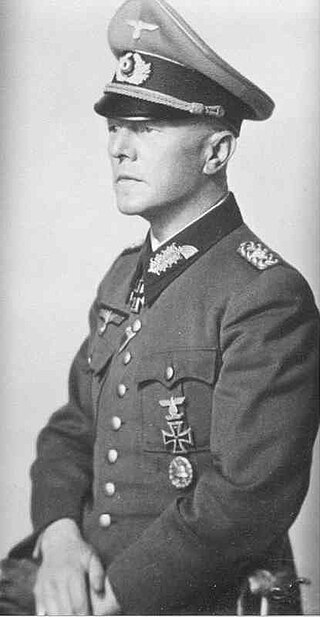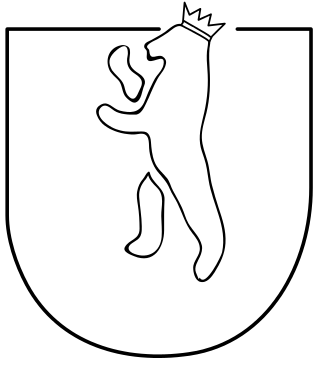The 1st Infantry Division was an infantry division that notably served in World War II as part of the Heer of Nazi Germany's Wehrmacht. It had been one of the original infantry divisions of the Reichswehr.

The 13th Panzer Division was a unit of the German Army during World War II, established in 1940.

The 16th Infantry Division of the German Army was formed in 1934. On 26 August 1939 the division was mobilized for the invasion of Poland (1939). It participated in the Battle of France in August 1940. The division was then split, resulting in two independent units: The 16th Panzer Division and the 16th Motorized Infantry Division. Then later, from 1944 onward, combined with other non 16th elements, was known as the 116th Panzer Division.
The 164th Infantry Division was an infantry division of the German Army during World War II. Formed in November 1939, the division took part in the invasion of Greece in April 1941. In January 1942, consolidating the Axis seizure of the island during the Battle of Crete, the 164th was reorganized as Fortress Division Kreta (FDK). In mid-1942 the division was transferred to North Africa and re-designated as 164th Light Africa Division, also alternatively spelt 164th Light Afrika Division in some anglophone literature. It surrendered in May 1943 in Tunisia at the end of the North African Campaign.

The 2nd Mountain Division was a Gebirgsjäger division of the German Army which served in World War II, mainly in the northernmost sector of the Eastern Front, near the Arctic. Formed in 1938, the division was disbanded at the end of the war in 1945.

The 212th Infantry Division was a German infantry division that fought in World War II. It was destroyed in Lithuania, and reconstituted as the 578th Volksgrenadier Division before being renamed the 212th Volksgrenadier Division.

The 6th Panzer Division was an armoured division in the German Army, the Heer, during World War II, established in October 1939.

The 4th Panzer Division was an armored division in the Army of Nazi Germany.

Hans Emil Otto Graf von Sponeck was a German general during World War II who was imprisoned for disobeying orders and later executed.

The 83rd Infantry Division,, was a German reserve and security formation during World War II.
The 320th Infantry Division was an infantry division of the German Wehrmacht. It existed from 1940 to 1944. In late 1944, the division was reassembled as the 320th Volksgrenadier Division.
The 101st Jäger Division was a light infantry Division of the German Army in World War II. It was formed in July 1942 by the redesignation of the 101st (Light) Infantry Division, which was itself formed in December 1940. The Walloon Legion was briefly attached to this division from December 1941 to January 1942. The Division took part in the Battle of Kharkov, the Battle of the Caucasus, and the retreat into the Kuban, where it suffered heavy losses fighting both the Red Army and partisans. The division was then involved in the battles in the Kuban bridgehead before being evacuated. The 101st was subsequently transferred to the lower Dnieper River in late 1943. It was part of the 1st Panzer Army that was surrounded in March 1944; it formed the rear guard for the XLVI Panzer Corps during the breakout of the Kamenets-Podolsky pocket. The division then retreated across Ukraine. In October 1944, it was moved to Slovakia and took part in the Battle of the Dukla Pass.

The 45th Infantry Division was an infantry division of the army of Nazi Germany during World War II. Towards the end of the war, the division was reassembled into a second iteration, the 45th Volksgrenadier Division

The 30th Infantry Division of the Wehrmacht was created on 1 October 1936 in Lübeck and mobilized on 26 August 1939 for the upcoming invasion of Poland. At that time, it consisted of the usual German infantry division elements: three infantry regiments of three battalions each, one three-battalion regiment of light artillery, one battalion of heavy artillery, a panzerjager (anti-tank) battalion, an aufklärungs (reconnaissance) battalion, a signals battalion, a pioneer (engineer) battalion, and divisional supply, medical, and administrative units.

The 31st Infantry Division was a German infantry division of the Army during World War II. It participated in the invasion of Poland in 1939 then the invasion of France and the Low Countries in 1940. As part of Panzergruppe 2. of Army Group Centre, it was involved in the invasion of the Soviet Union in June 1941. After hard fighting throughout 1941 and 1942 it joined the 9th Army and fought in the Battle of Kursk in July and August 1943. Along with the rest of the 9th Army, the division conducted a fighting withdrawal for the remainder of 1943, during which it sustained heavy casualties. In the early stages of the Soviet Operation Bagration of June to August 1944, the 31st Infantry Division was destroyed, a fate which subsequently befell most of Army Group Centre. The division was officially disbanded on 18 July 1944.
The 462nd Volksgrenadier Division was a Volksgrenadier division of the German Army during the Second World War, active from 1942 to 1944. It was initially known as Division Nr. 462 and subsequently became the 462nd Infantry Division before assuming its Volksgrenadier designation in late 1944.
The 361st Infantry Division was an infantry division of the German Army during the Second World War, active from 1943 to 1945. It was redesignated as a Volksgrenadier division in 1944. It saw active service on the Eastern Front when the Soviets launched Operation Bagration, during which it suffered significant losses. It later fought in France before being absorbed by the 559th Volksgrenadier Division on 10 March 1945.

The 387th Infantry Division was an infantry division of the German Army during the Second World War, active from 1942 to 1944. It saw active service on the Eastern Front and was destroyed in fighting in Romania in August 1944.

XXXXII Army Corps was a corps in the German Army during World War II.

The 257th Infantry Division was an infantry division of the German Army during World War II.















